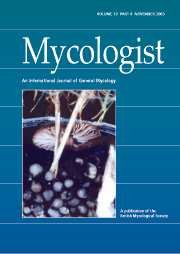Crossref Citations
This article has been cited by the following publications. This list is generated based on data provided by
Crossref.
IMANI, JAFARGHOLI
BALTRUSCHAT, HELMUT
STEIN, ELKE
JIA, GENGXIANG
VOGELSBERG, JÖRG
KOGEL, KARL‐HEINZ
and
HÜCKELHOVEN, RALPH
2006.
Expression of barley BAX Inhibitor‐1 in carrots confers resistance to Botrytis cinerea.
Molecular Plant Pathology,
Vol. 7,
Issue. 4,
p.
279.
Eshel, Dani
Regev, Refael
Orenstein, Janeta
Droby, Samir
and
Gan-Mor, Shmuel
2009.
Combining physical, chemical and biological methods for synergistic control of postharvest diseases: A case study of Black Root Rot of carrot.
Postharvest Biology and Technology,
Vol. 54,
Issue. 1,
p.
48.
Heller, Werner E
2012.
A new method of quantitative detection of Chalara elegans and C. thielavioides in soils using carrot discs.
Journal of Plant Diseases and Protection,
Vol. 119,
Issue. 5-6,
p.
169.
Hewajulige, I.G.N.
and
Wijesundera, R.L.C.
2014.
Postharvest Decay.
p.
287.
Lampert, Yael
Dror, Barak
Sela, Noa
Teper‐Bamnolker, Paula
Daus, Avinoam
Sela (Saldinger), Shlomo
and
Eshel, Dani
2017.
Emergence of Leuconostoc mesenteroides as a causative agent of oozing in carrots stored under non‐ventilated conditions.
Microbial Biotechnology,
Vol. 10,
Issue. 6,
p.
1677.
Mbenoun, Michael
Garnas, Jeffrey R.
Wingfield, Michael J.
Begoude Boyogueno, Aimé D.
and
Roux, Jolanda
2017.
Metacommunity analyses of Ceratocystidaceae fungi across heterogeneous African savanna landscapes.
Fungal Ecology,
Vol. 28,
Issue. ,
p.
76.
Kowalska, Beata
Smolińska, Urszula
Szczech, Magdalena
and
Winciorek, Jolanta
2017.
Application of organic waste material overgrown with Trichoderma atroviride as a control strategy for Sclerotinia sclerotiorum and Chalara thielavioides in soil.
Journal of Plant Protection Research,
Vol. 57,
Issue. 3,
p.
205.
Xu, Kecheng
Li, Jie
Yang, Xiaodi
Zhang, Ruiqi
Li, Xue
Xie, Mengsha
and
Huang, Qiong
2020.
Postharvest rot on carrot caused by Ceratocystis fimbriata and Chalaropsis thielavioides (≡ Thielaviopsis thielavioides) in China.
Journal of General Plant Pathology,
Vol. 86,
Issue. 4,
p.
322.
van der Nest, Magriet A.
Chávez, Renato
De Vos, Lieschen
Duong, Tuan A.
Gil-Durán, Carlos
Ferreira, Maria Alves
Lane, Frances A.
Levicán, Gloria
Santana, Quentin C.
Steenkamp, Emma T.
Suzuki, Hiroyuki
Tello, Mario
Rakoma, Jostina R.
Vaca, Inmaculada
Valdés, Natalia
Wilken, P. Markus
Wingfield, Michael J.
and
Wingfield, Brenda D.
2021.
IMA genome - F14.
IMA Fungus,
Vol. 12,
Issue. 1,
Papoutsis, Konstantinos
and
Edelenbos, Merete
2021.
Postharvest environmentally and human-friendly pre-treatments to minimize carrot waste in the supply chain caused by physiological disorders and fungi.
Trends in Food Science & Technology,
Vol. 112,
Issue. ,
p.
88.
Higgins, Douglas S.
and
Hausbeck, Mary K.
2023.
Handbook of Vegetable and Herb Diseases.
p.
1.




